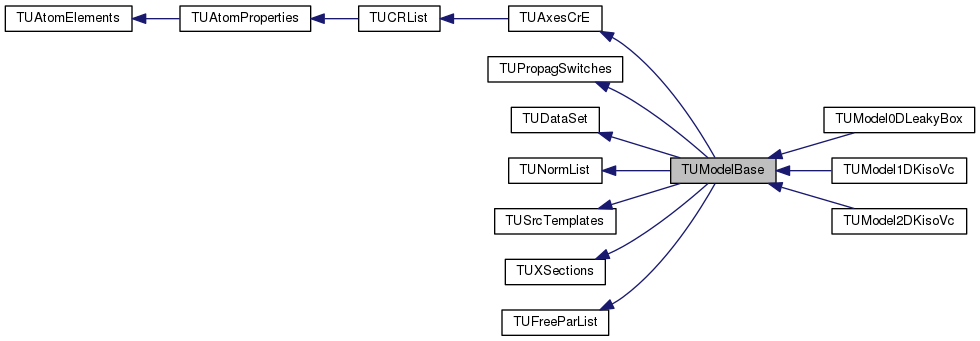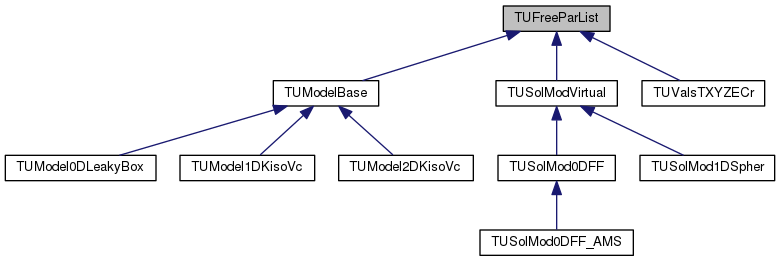4. Inside USINE (c++)¶
This section provide an overview of the code structure and organisation. A detailed description of each class content (members and role in the USINE ecology) is given in the header files (include/TU*.h).
4.1. Classes¶
Fig. 4.1 is a sketch of all USINE classes, grouped by items to underline the most relevant features of the code:
- CR physics (blue box, top): classes for CR base ingredients, with CR charts, data, and cross-sections set from input files — see USINE input files.
- USINE utilities (grey box, bottom): the most important class is
TUValsTXYZCrE.h, a handler for formula (or values on a grid) dependent on generic CR, energy, and space-time coordinates — see Tutorial: ./bin/usine. The dashed arrows indicate the classes involved and where it is used (for transport, ISM description, and source parameters).- Models (orange box, right-hand side): dedicated classes for Galactic propagation and Solar modulation models.
- Initialisation parameters (red box, left-hand side): class reading the parameter file (see Initialisation file) to set and initialise all classes for a run.
- Free parameters (red box, centre): class handling all fit-able parameters. Red arrows connecting red boxes highlight classes with free parameters (spatial coordinates, XS, ISM, transport, sources, Solar modulation) — see Fit parameters and minimizer for the syntax.
4.2. Inheritance diagrams¶
Two important classes in USINE largely rely on inheritance: Fig. 4.2 and Fig. 4.3 below were obtained with Doxygen (enabling graphviz).
| Structure of propagation model classes (class TUModelBase.h): | |
|---|---|
|
|
| Structure of free parameters (class TUInitPars.h): | |
if existing, the free parameters of a class are stored in a TUFreeParList object. They are themselves collected in a global list of free parameters. This allows a very simple declaration of the parameters the user wishes to let free in a minimisation (see Fit parameters and minimizer) |
|
4.3. Enumerators¶
USINE relies on many enumerators. Most of these enumerators are for developers only, but some of them are relevant for users as well, as given in Table 4.1. The complete list of enumerators is defined in $USINE/include/TUEnum.h.
| Enumerator | Description | Enabled |
|---|---|---|
gENUM_ETYPE |
Energy unit/type for data and plots | kEKN, kR, kETOT, kEK for kinetic energy per nucleon [GeV/n], rigidity [GV], total energy [GeV], and kinetic energy [GeV] |
gENUM_ERRTYPE |
Handling of data errors | kERRSTAT, kERRSYST, kERRTOT, kERRCOV for statistical, systematics, total (stat+syst in quadrature), or covariance |
gENUM_FCNTYPE |
Parametrisation | kFORMULA, kGRID for a formula or a grid of values |
gENUM_PROPAG_MODEL |
Propagation models | kMODEL0DLEAKYBOX, kMODEL1DKISOVC, kMODEL2DKISOVC for Leaky-Box, 1D, or 2D semi-analytical diffusion model |
gENUM_SOLMOD_MODEL |
Solar modulation models | kSOLMOD0DFF for Force-Field approximation |
4.4. Coding conventions¶
If ever you want to have a look at the code, or develop some new modules, it may be useful to know that USINE relies loosely on the coding conventions used in ROOT. In addition, we use the following syntax:
- lower_case_underscore_separated \(\rightarrow\) local variables
- UpperCaseSeparated \(\rightarrow\) method names
- gUPPERCASE \(\rightarrow\) global variables
- kUPPERCASE \(\rightarrow\) enumerators (see list of enumerators above)
To ensure homogeneity in the indentation throughout USINE sources (*.cc files), we use astyle and the ROOT/CERN style obtained by copying the lines below in ~/.astylerc:
# ROOT code formatting style--style=stroustrup--mode=c--align-pointer=name--indent=spaces=3--indent-switches--indent-cases--indent-namespaces--max-instatement-indent=40--indent-preprocessor--convert-tabs--pad-header--pad-oper--unpad-paren

